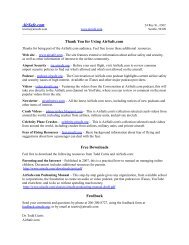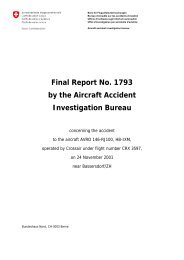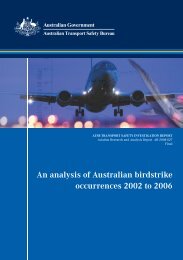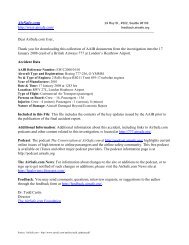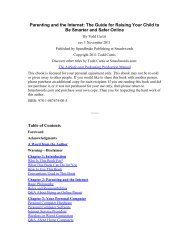Event Sequence Analysis - Bird Strikes - Airline Safety and Security ...
Event Sequence Analysis - Bird Strikes - Airline Safety and Security ...
Event Sequence Analysis - Bird Strikes - Airline Safety and Security ...
Create successful ePaper yourself
Turn your PDF publications into a flip-book with our unique Google optimized e-Paper software.
Conclusions<br />
• <strong>Analysis</strong> of past bird strike related accidents identified thirteen events that were directly<br />
involved in the outcome of those accidents (Table 2).<br />
• <strong>Analysis</strong> of past bird strike related hull loss accidents identified four events that were not<br />
directly involved in the outcome of those accidents, but could become a factor in future<br />
accidents (Table 3).<br />
• These 17 events form a minimum set of events or conditions that should be included in any risk<br />
assessment of hull loss risks from bird strikes during takeoff.<br />
• An event sequence map can be used to develop a concise summary of the sequences of events<br />
that led to the eight accidents studied.<br />
• In three of the eight accidents, decisions made by the flight crew directly contributed to the<br />
accident.<br />
Discussion<br />
One worthwhile way to use insights from this particular event sequence analysis would be to help put<br />
the findings <strong>and</strong> recommendations of the ongoing investigation of the US Airways A320 ditching into<br />
a broader context. One broader context would be other accidents <strong>and</strong> serious incidents involving birds.<br />
For example, if the insights gained from the current investigation are largely the same as those gained<br />
in the past, then it may call into question how effective industry <strong>and</strong> government have been in taking<br />
actions that would reduce the likelihood of these kinds of risks.<br />
Another broader context may be other safety issues that have been recognized as a serious risk by the<br />
airline industry <strong>and</strong> that have similarities to the kinds of patterns revealed in this study. One kind of<br />
risk that meets these criteria is the improvement of runway safety, specifically reducing risks from<br />
runway incursions. The FAA, NTSB, <strong>and</strong> other aviation organizations have identified reducing such<br />
incursions as a worthwhile goal. While a combination of improved technology <strong>and</strong> improved<br />
procedures have reduced the risk, there is still plenty of room for improvement. The kind of analysis<br />
performed for the eight bird strike accidents in this study can serve as a model for a similar analysis of<br />
runway incursion events.<br />
One of the key insights from my research into bird strike related accidents is that at critical points<br />
during the accident sequence, flight crews sometimes make decisions based on their interpretation of<br />
visual, auditory, <strong>and</strong> kinesthetic sensory information generated by the presence of birds or from the<br />
effects of strikes. While such information may not be reflected in their instruments, <strong>and</strong> while many<br />
routine <strong>and</strong> emergency procedures do not incorporate these kinds of inputs, those inputs can most<br />
certainly affect a pilot's decisions.<br />
Comparison of Eight Serious <strong>Bird</strong> Strike Accidents Page 10<br />
Dr. Todd Curtis , AirSafe.com Foundation Revised 1/22/09



